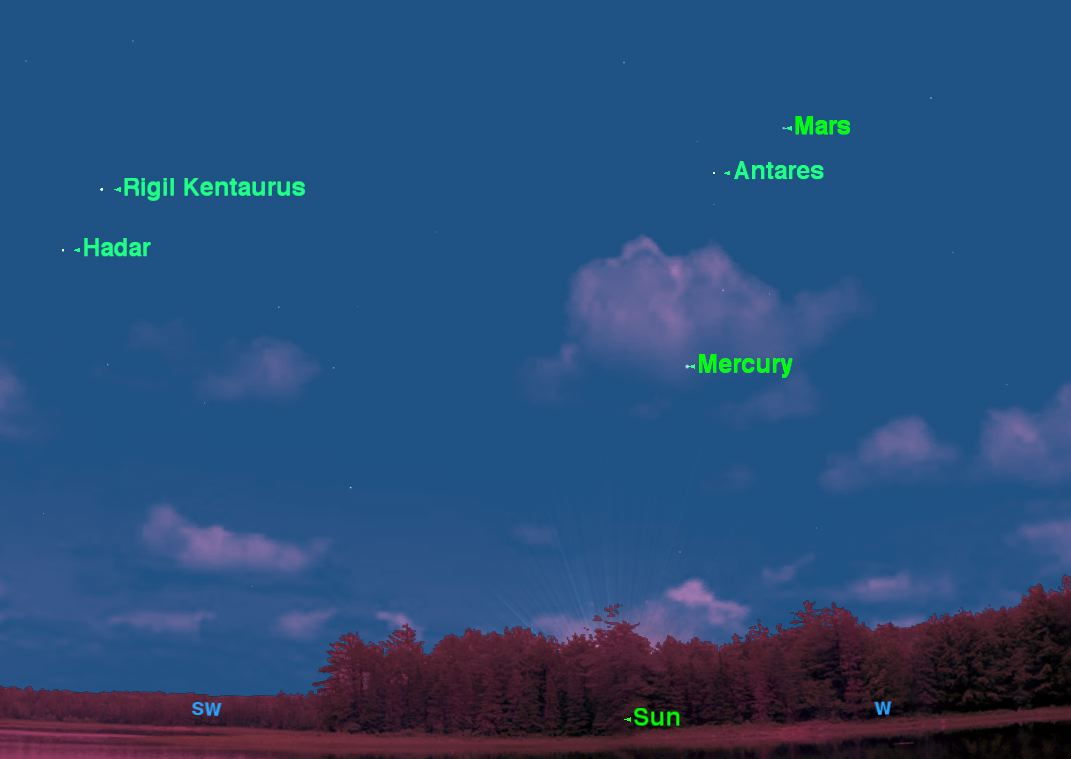Elusive Mercury at Its Best Now for Southern Stargazers

The planet Mercury is one of the brightest objects in the sky, but the elusive rocky world is always a challenge to observe, though it is a prime target for planet-seeking observers in the Southern Hemisphere.
Because Mercury orbits close to our sun, it never strays far from the sun's bright glow. Even when it is farthest from the sun, as it is this week, Mercury's position in the sky often makes it difficult to see.
The problem is that the angle which the ecliptic — the path that the sun, moon, and planets follow across the sky — is sometimes tilted so that it makes a shallow angle with the horizon. So, even though Mercury is far from the sun, it is still very close to the horizon at sunset.
This is the situation this week for observers in the Northern Hemisphere. As usually happens, a poor angle for northern observers turns out to be a good angle for Southern Hemisphere observers. The sky map accompanying this guide shows the view of as viewed from Melbourne, Australia.
From Melbourne, the ecliptic appears to rise almost straight up from the horizon, putting Mercury in a very favorable spot. Mars is even higher above the horizon, and the bright red giant star Antares is between the two. Off to the left are two more bright stars, Rigil Kentaurus and Hadar.
"Rigil Kentaurus" is an alternative name for the star system also known as Alpha Centauri, which has been much in the news in the last few days because of the discovery of an Earth-sized planet around one of its component stars.
Southern observers may need to wait a while after sunset for the sky to darken enough to let them spot Mercury and its companions; binoculars will help.
Get the Space.com Newsletter
Breaking space news, the latest updates on rocket launches, skywatching events and more!
Northern observers will have a much more difficult time. Mercury, Mars and Antares will be much lower in the sky, way off to the left of the setting sun, and Hadar and Rigil Kentaurus will be completely below their horizon.
This article was provided to SPACE.com by Starry Night Education, the leader in space science curriculum solutions. Follow Starry Night on Twitter @StarryNightEdu.
Join our Space Forums to keep talking space on the latest missions, night sky and more! And if you have a news tip, correction or comment, let us know at: community@space.com.

Geoff Gaherty was Space.com's Night Sky columnist and in partnership with Starry Night software and a dedicated amateur astronomer who sought to share the wonders of the night sky with the world. Based in Canada, Geoff studied mathematics and physics at McGill University and earned a Ph.D. in anthropology from the University of Toronto, all while pursuing a passion for the night sky and serving as an astronomy communicator. He credited a partial solar eclipse observed in 1946 (at age 5) and his 1957 sighting of the Comet Arend-Roland as a teenager for sparking his interest in amateur astronomy. In 2008, Geoff won the Chant Medal from the Royal Astronomical Society of Canada, an award given to a Canadian amateur astronomer in recognition of their lifetime achievements. Sadly, Geoff passed away July 7, 2016 due to complications from a kidney transplant, but his legacy continues at Starry Night.










